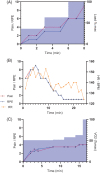Diagnosis and management of children with McArdle Syndrome (GSD V) in New South Wales
- PMID: 37701325
- PMCID: PMC10494502
- DOI: 10.1002/jmd2.12389
Diagnosis and management of children with McArdle Syndrome (GSD V) in New South Wales
Abstract
Glycogen storage type V (GSD V-McArdle Syndrome) is a rare neuromuscular disorder characterised by severe pain early after the onset of physical activity. A recent series indicated a diagnostic delay of 29 years; hence reports of children affected by the disorder are uncommon (Lucia et al., 2021, Neuromuscul Disord, 31, 1296-1310). This paper presents eight patients with a median onset age of 5.5 years and diagnosis of 9.5 years. Six patients had episodes of rhabdomyolysis with creatine kinase elevations >50 000 IU/L. Most episodes occurred in relation to eccentric non-predicted activities rather than regular exercise. One of the patients performed a non-ischaemic forearm test. One patient was diagnosed subsequent to a skeletal muscle biopsy, and all had confirmatory molecular genetic diagnosis. Three were homozygous for the common PYGM:c.148C > T (p.Arg50*) variant. All but one patient had truncating variants. All patients were managed with structured exercise testing to help them identify 'second-wind', and plan an exercise regimen. In addition all also had an exercise test with 25 g maltodextrin which had statistically significant effect on ameliorating ratings of perceived exertion. GSD V is under-recognised in paediatric practice. Genetic testing can readily diagnose the condition. Careful identification of second-wind symptomatology during exercise with the assistance of a multi-disciplinary team, allows children to manage activities and tolerate exercise. Maltodextrin can be used for structured exercise, but excessive utilisation may lead to weight gain. Early intervention and education may improve outcomes into adult life.
Keywords: McArdle; VO2 max; aerobic; exercise; glycogen storage; rhabdomyolysis; sports physiology.
© 2023 The Authors. JIMD Reports published by John Wiley & Sons Ltd on behalf of SSIEM.
Conflict of interest statement
All authors declare no competing interest.
Figures


Similar articles
-
Impaired glycogen breakdown and synthesis in phosphoglucomutase 1 deficiency.Mol Genet Metab. 2017 Nov;122(3):117-121. doi: 10.1016/j.ymgme.2017.08.007. Epub 2017 Aug 25. Mol Genet Metab. 2017. PMID: 28882528
-
McArdle Disease: Insights Into a Rare Metabolic Myopathy in a Young Boy With Recurrent Exercise-Induced Muscle Weakness.Cureus. 2025 Feb 4;17(2):e78490. doi: 10.7759/cureus.78490. eCollection 2025 Feb. Cureus. 2025. PMID: 40051944 Free PMC article.
-
The phenotypic and genotypic features of a Scottish cohort with McArdle disease.Neuromuscul Disord. 2021 Aug;31(8):695-700. doi: 10.1016/j.nmd.2021.05.009. Epub 2021 May 30. Neuromuscul Disord. 2021. PMID: 34215481
-
McArdle disease: a unique study model in sports medicine.Sports Med. 2014 Nov;44(11):1531-44. doi: 10.1007/s40279-014-0223-5. Sports Med. 2014. PMID: 25028051 Review.
-
McArdle disease: what do neurologists need to know?Nat Clin Pract Neurol. 2008 Oct;4(10):568-77. doi: 10.1038/ncpneuro0913. Nat Clin Pract Neurol. 2008. PMID: 18833216 Review.
References
-
- Lucia A, Martinuzzi A, Nogales‐Gadea G, Quinlivan R, Reason S, International Association for Muscle Glycogen Storage Disease study group . Clinical practice guidelines for glycogen storage disease V & VII (McArdle disease and Tarui disease) from an international study group. Neuromuscul Disord. 2021;31:1296‐1310. doi:10.1016/j.nmd.2021.10.006 - DOI - PubMed
Publication types
LinkOut - more resources
Full Text Sources

